Climate Change Characteristics of Typical Grassland in the Mongolian Plateau from 1978 to 2020
Abstract
1. Introduction
2. Study Area
3. Data and Methodology
3.1. Data
3.2. Methodology
3.2.1. Univariate Linear Regression Analysis
3.2.2. Mutation Detection
3.2.3. Morlet Wavelet Analysis
4. Results
4.1. Temporal Variation Characteristics of Temperature, Precipitation and Maximum Wind Speed
4.1.1. Interannual and Seasonal Variations in Temperature, Precipitation and Maximum Wind Speed
4.1.2. Abrupt Change Detection of Annual Average Temperature, Annual Precipitation and Annual Average Maximum Wind Speed
4.1.3. Periodic Variation of Annual Average Temperature, Annual Precipitation and Annual Average Maximum Wind Speed
4.2. Temporal Variation Characteristics of Temperature, Precipitation and Maximum Wind Speed
4.2.1. Spatial Variation of Temperature
4.2.2. Spatial Variation of Precipitation
4.2.3. Spatial Variation of Maximum Wind Speed
5. Discussion
6. Conclusions
- (1)
- The spatial and temporal pattern evolution of temperature was studied. In the past 40 years, the annual average temperature of the typical grassland on the Mongolian Plateau showed a significant upward trend, with a climate tendency rate of 0.4 °C/10a (p < 0.001), and the warming range gradually increased from northeast to southwest, with the most obvious warming in the southwest. The average temperature of the four seasons showed a warming trend, especially in spring and summer. The annual average temperature changed from low temperature to high temperature in 1992, and there was a significant 32-year cycle change.
- (2)
- The evolution characteristics of precipitation on different spatial and temporal scales were studied, and the annual precipitation showed a slightly decreasing trend with a climatic trend rate of −2.39 mm/10a. The precipitation change showed a decreasing trend at both ends, and precipitation increased in the middle region and the southern part, while the precipitation decreased most obviously in the northern part. Among the seasonal variations, summer precipitation decreased the most. The annual precipitation changed from more to less in 1998, and there was a significant 29-year cycle change.
- (3)
- The temporal and spatial evolution characteristics of the maximum wind speed were clarified, and the annual average maximum wind speed showed a significant decreasing trend, with a climate trend rate of −0.33 m/s/10a (p < 0.001), and the maximum wind speed decreased most significantly in the south and northeast. In terms of seasonal variation, the average maximum wind speed decreased in all seasons, with the greatest decrease in spring. The annual average maximum wind speed changed from strong to weak around 1991, and there was a significant 28-year cycle change.
- (4)
- The decadal evolution of the typical steppe on the Mongolian Plateau was revealed. From the perspective of the whole study period, the typical steppe climate of the Mongolian Plateau is characterized by rising temperature, decreasing precipitation and decreasing maximum wind speed, which leads to the trend of warming and drying and weak weathering. In the past 40 years, the climate type showed a change process of “cold wet, strong wind–warm dry, weak wind”.
Author Contributions
Funding
Data Availability Statement
Acknowledgments
Conflicts of Interest
References
- Chen, S.; Yu, B.; Wu, R.; Chen, W.; Song, L. The dominant North Pacific atmospheric circulation patterns and their relations to Pacific SSTs: Historical simulations and future projections in the IPCC AR6 models. Clim. Dyn. 2020, 56, 701–725. [Google Scholar] [CrossRef]
- Lynn, J.; Peeva, N. Communications in the IPCC’s Sixth Assessment Report cycle. Clim. Change 2021, 169, 18. [Google Scholar] [CrossRef] [PubMed]
- Ying, S. Impact of humanactivities on climate system: An interpretation of Chapter III of WGI report of IPCC AR6. J. Atmos. Sci. 2021, 44, 654–657. [Google Scholar] [CrossRef]
- Huang, J.; Guan, X.; Ji, F. Enhanced cold-season warming in semi-arid regions. Atmos. Chem. Phys. 2012, 12, 5391–5398. [Google Scholar] [CrossRef]
- Huang, J.; Ji, M.; Xie, Y.; Wang, S.; He, Y.; Ran, J. Global semi-arid climate change over last 60 years. Clim. Dyn. 2015, 46, 1131–1150. [Google Scholar] [CrossRef]
- Huang, J.; Li, Y.; Fu, C.; Chen, F.; Fu, Q.; Dai, A.; Shinoda, M.; Ma, Z.; Guo, W.; Li, Z.; et al. Dryland climate change: Recent progress and challenges. Rev. Geophys. 2017, 55, 719–778. [Google Scholar] [CrossRef]
- Liao, L.; Jiang, C.; He, B.; Liu, Q.; Zhu, F.; Cui, X. Response of vegetation coverage to climate change in Mongolian Plateau during recent 10 year. Acta Ecol. Sin. 2014, 34, 1295–1301. [Google Scholar] [CrossRef][Green Version]
- John, R.; Chen, J.; Ou-Yang, Z.-T.; Xiao, J.; Becker, R.; Samanta, A.; Ganguly, S.; Yuan, W.; Batkhishig, O. Vegetation response to extreme climate events on the Mongolian Plateau from 2000 to 2010. Environ. Res. Lett. 2013, 8, 035033. [Google Scholar] [CrossRef]
- Liu, Z.; Wang, R.; Yao, Z. Air temperature and precipitation over the Mongolian Plateau and assessment of CMIP 5 climate models. Resour. Sci. 2016, 38, 956–969. [Google Scholar] [CrossRef]
- Qin, F.-Y.; Jia, G.-S.; Yang, J.; Na, Y.-T.; Hou, M.-T.; Narenmandula. Spatiotemporal variability of precipitation during 1961–2014 across the Mongolian Plateau. J. Mt. Sci. 2018, 15, 992–1005. [Google Scholar] [CrossRef]
- Hu, Q.; Pan, F.; Pan, X.; Zhang, D.; Li, Q.; Pan, Z.; Wei, Y. Spatial analysis of climate change in Inner Mongolia during 1961–2012, China. Appl. Geogr. 2015, 60, 254–260. [Google Scholar] [CrossRef]
- Tong, S.; Zhang, J.; Bao, Y.; Wurina; Terigele; Weilisi; Lianxiao. Spatial and temporal variations of vegetation cover and the relationships with climate factors in Inner Mongolia based on GIMMS NDVI3g data. J. Arid Land 2017, 9, 394–407. [Google Scholar] [CrossRef]
- Li, H.; Ma, L.; Liu, T. Change and relationship of temperature and precipitation in Inner Mongolia during 1951–2014. J. Glaciol. Geocryol. 2017, 39, 1098–1112. [Google Scholar] [CrossRef]
- Davi, N.K.; Pederson, N.; Leland, C.; Nachin, B.; Suran, B.; Jacoby, G.C. Is eastern Mongolia drying? A long-term perspective of a multidecadal trend. Water Resour. Res. 2013, 49, 151–158. [Google Scholar] [CrossRef]
- Nandintsetseg, B.; Greene, J.S.; Goulden, C.E. Trends in extreme daily precipitation and temperature near lake Hövsgöl, Mongolia. Int. J. Climatol. 2007, 27, 341–347. [Google Scholar] [CrossRef]
- Sternberg, T.; Thomas, D.; Middleton, N. Drought dynamics on the Mongolian steppe, 1970–2006. Int. J. Climatol. 2011, 31, 1823–1830. [Google Scholar] [CrossRef]
- Vandandorj, S.; Munkhjargal, E.; Boldgiv, B.; Gantsetseg, B. Changes in event number and duration of rain types over Mongolia from 1981 to 2014. Environ. Earth Sci. 2017, 76, 70. [Google Scholar] [CrossRef]
- Angerer, J.; Han, G.; Fujisaki, I.; Havstad, K. Climate change and ecosystems of Asia with emphasis on Inner Mongolia and Mongolia. Rangelands 2008, 30, 46–51. [Google Scholar] [CrossRef]
- Liu, S.; Wang, T. Climate change and local adaptation strategies in the middle Inner Mongolia, northern China. Environ. Earth Sci. 2011, 66, 1449–1458. [Google Scholar] [CrossRef]
- Zhang, C.; Zhang, Y.; Li, J. Grassland Productivity Response to Climate Change in the Hulunbuir Steppes of China. Sustainability 2019, 11, 6760. [Google Scholar] [CrossRef]
- Bao, G.; Liu, Y.; Liu, N.; Linderholm, H.W. Drought variability in eastern Mongolian Plateau and its linkages to the large-scale climate forcing. Clim. Dyn. 2014, 44, 717–733. [Google Scholar] [CrossRef]
- Li, X.; Bai, M.; Yang, J.; Di, R.; Gao, Z. Risk zonation and evaluation of rainstorm and flood disasters in Inner Mongolia based on GIS. J. Arid Land Resour. Environ. 2012, 26, 71–77. [Google Scholar] [CrossRef]
- Yulong, B.; Laiquan; Lina; Song, J.; Hugejiletu; Yuhai, B.; Sachula. Analysis of Monitoring Method of Grassland Winter Drought Disaster Based on MOD10A1. J. Catastrophol. 2017, 32, 54–58. [Google Scholar] [CrossRef]
- Liu, X.; Zhang, J.; Tong, Z.; Bao, Y.; Zhang, D. Grid-Based Multi-Attribute Risk Assessment of Snow Disasters in the Grasslands of Xilingol, Inner Mongolia. Hum. Ecol. Risk Assess. Int. J. 2011, 17, 712–731. [Google Scholar] [CrossRef]
- Bao, C.; Yong, M.; Bi, L.; Gao, H.; Li, J.; Bao, Y.; Gomboludev, P. Impacts of Underlying Surface on the Dusty Weather in Central Inner Mongolian Steppe, China. Earth Space Sci. 2021, 8, e2021EA001672. [Google Scholar] [CrossRef]
- Wang, H.; Li, Z.; Han, J. The spatial—Temporal change law of precipitation in Xilinguole steppe zone. J. Arid Land Resour. Environ. 2012, 26, 24–27. [Google Scholar] [CrossRef]
- Qu, X.; Wu, H. Analysis of 53-year climate change characteristics of Hulun Buir city. Res. Soil Water Conserv. 2014, 21, 178–182. [Google Scholar] [CrossRef]
- Qin, F.-Y. Study on the Response of the Temporal and Spatial Pattern of the Vegetation on the Mongolian Plateau to Climate Change. Ph.D. Thesis, Inner Mongolia University, Hohhot, China, 2019. [Google Scholar]
- Dan, D. Climate Change on the Mongolian Plateau in the Past 35 years. Master’s Thesis, Inner Mongolia Normal University, Hohhot, China, 2014. [Google Scholar]
- He, W.; Bu, R.; Xiong, Z.; Hu, Y. Characteristics of temperature and precipitation in Northeastern China from 1961 to 2005. Acta Ecol. Sin. 2013, 33, 519–531. [Google Scholar] [CrossRef]
- Fu, C. The definition and detection of the abrupt climatic change. Sci. Atmos. Sin. 1992, 16, 482–493. [Google Scholar]
- Wu, J.; Sheng, Z.; Du, J.; Zhang, Y.; Zhang, J. Spatiotemporal change patterns of temperature and precipitation in Northeast China from 1956 to 2017. Res. Soil Water Conserv. 2021, 28, 340–347. [Google Scholar] [CrossRef]
- Kahya, E.; Kalaycı, S. Trend analysis of streamflow in Turkey. J. Hydrol. 2004, 289, 128–144. [Google Scholar] [CrossRef]
- Zhang, Q.; Jiang, T.; Gemmer, M.; Becker, S. Precipitation, temperature and runoff analysis from 1950 to 2002 in the Yangtze basin, China. Hydrol. Sci. J. 2005, 50, 65–80. [Google Scholar] [CrossRef]
- Miao, C.; Ni, J.; Borthwick, A.G. Recent changes of water discharge and sediment load in the Yellow River basin, China. Prog. Phys. Geogr. 2010, 34, 541–561. [Google Scholar] [CrossRef]
- Zhang, J.; Wang, Y. Uncertainty analysis of rainfall-runoff relationship in Zhengzhou City. Water Resour. Prot. 2021, 37, 1–6. [Google Scholar] [CrossRef]
- Kai, L.; Gege, N.; ZHANG, S. Study on the spatiotemporal evolution of temperature and precipitation in China from 1951 to 2018. Adv. Earth Sci. 2020, 35, 1113–1126. [Google Scholar] [CrossRef]
- Xu, W.; Li, Q.; Jones, P.; Wang, X.L.; Trewin, B.; Yang, S.; Zhu, C.; Zhai, P.; Wang, J.; Vincent, L.; et al. A new integrated and homogenized global monthly land surface air temperature dataset for the period since 1900. Clim. Dyn. 2017, 50, 2513–2536. [Google Scholar] [CrossRef]
- Zhang, Y. Analysis of Temporal-Spatial Variation Characteristics of Max Windspeed during 1976–2017 in Inner Mongolia. Meteorol. J. Inn. Mong. 2019, 4, 22–25. [Google Scholar] [CrossRef]
- Ma, Z.; Yu, H.; Zhang, Q.; Cao, C. Characteristics and abrupt change of temperature and precipitation in inner Mongolia area over the period 1960–2016. Res. Soil Water Conserv. 2019, 26, 114–121. [Google Scholar] [CrossRef]
- Li, X.; Han, G.; Guo, C. Impacts of climate change on dominant pasture growing season in central Inner Mongolia. Acta Ecol. Sin. 2013, 33, 4146–4155. [Google Scholar] [CrossRef]
- Piao, J.; Chen, W.; Chen, S. Water vapour transport changes associated with the interdecadal decrease in the summer rainfall over Northeast Asia around the late-1990s. Int. J. Climatol. 2021, 41, E1469–E1482. [Google Scholar] [CrossRef]
- Kang, X.; Cong-wen, Z.H.; Jin-hai, H. Impact of the Surface Air Temperature Warming around Lake Baikal on Trend of Summer Precipitation in North China in the Past 50 Years. Plateau Meteorol. 2011, 30, 309–317. [Google Scholar]
- Zhu, Y.; Wang, H.; Zhou, W.; Ma, J. Recent changes in the summer precipitation pattern in East China and the background circulation. Clim. Dyn. 2010, 36, 1463–1473. [Google Scholar] [CrossRef]
- Han, T.; Chen, H.; Wang, H. Recent changes in summer precipitation in Northeast China and the background circulation. Int. J. Climatol. 2015, 35, 4210–4219. [Google Scholar] [CrossRef]
- Feng, K.; Ying, L.; Yi-fei, W.; Lili, L.; Lin, L.; Dong, L.; Yuan, X. Spatial and Temporal Variation Characteristics of Near-surface Gale Days in China from 1961 to 2016. J. Anhui Agri. Sci. 2017, 45, 188–196. [Google Scholar] [CrossRef]
- Tong, S.; Liu, G.; Wu, N. Temporal spatial changes of temperature and precipitation in Xilingol League from 1961 to 2010. Bull. Soil Water Conserv. 2016, 36, 340–345. [Google Scholar] [CrossRef]
- Liu, Y.; Zhuang, Q.; Chen, M.; Pan, Z.; Tchebakova, N.; Sokolov, A.; Kicklighter, D.; Melillo, J.; Sirin, A.; Zhou, G. Response of evapotranspiration and water availability to changing climate and land cover on the Mongolian Plateau during the 21st century. Glob. Planet. Change 2013, 108, 85–99. [Google Scholar] [CrossRef]
- Miao, L.; Fraser, R.; Sun, Z.; Sneath, D.; He, B.; Cui, X. Climate impact on vegetation and animal husbandry on the Mongolian Plateau: A comparative analysis. Nat. Hazards 2016, 80, 727–739. [Google Scholar] [CrossRef]
- Bailing, M.; Zhiyong, L.; Cunzhu, L.; Lixin, W.; Chengzhen, J.; Fuxiang, B.; Chao, J. Temporal and spatial heterogeneity of drought impact on vegetation growth on the Inner Mongolian Plateau. Rangel. J. 2018, 40, 113–128. [Google Scholar] [CrossRef]
- Nanzad, L.; Zhang, J.; Tuvdendorj, B.; Yang, S.; Rinzin, S.; Prodhan, F.A.; Sharma, T.P.P. Assessment of Drought Impact on Net Primary Productivity in the Terrestrial Ecosystems of Mongolia from 2003 to 2018. Remote Sens. 2021, 13, 2522. [Google Scholar] [CrossRef]
- Zhao, D.; Gao, X.; Wu, S.; Zheng, D. Trend of climate variation in China from 1960 to 2018 based on natural regionalization. Adv. Earth Sci. 2020, 35, 750–760. [Google Scholar] [CrossRef]

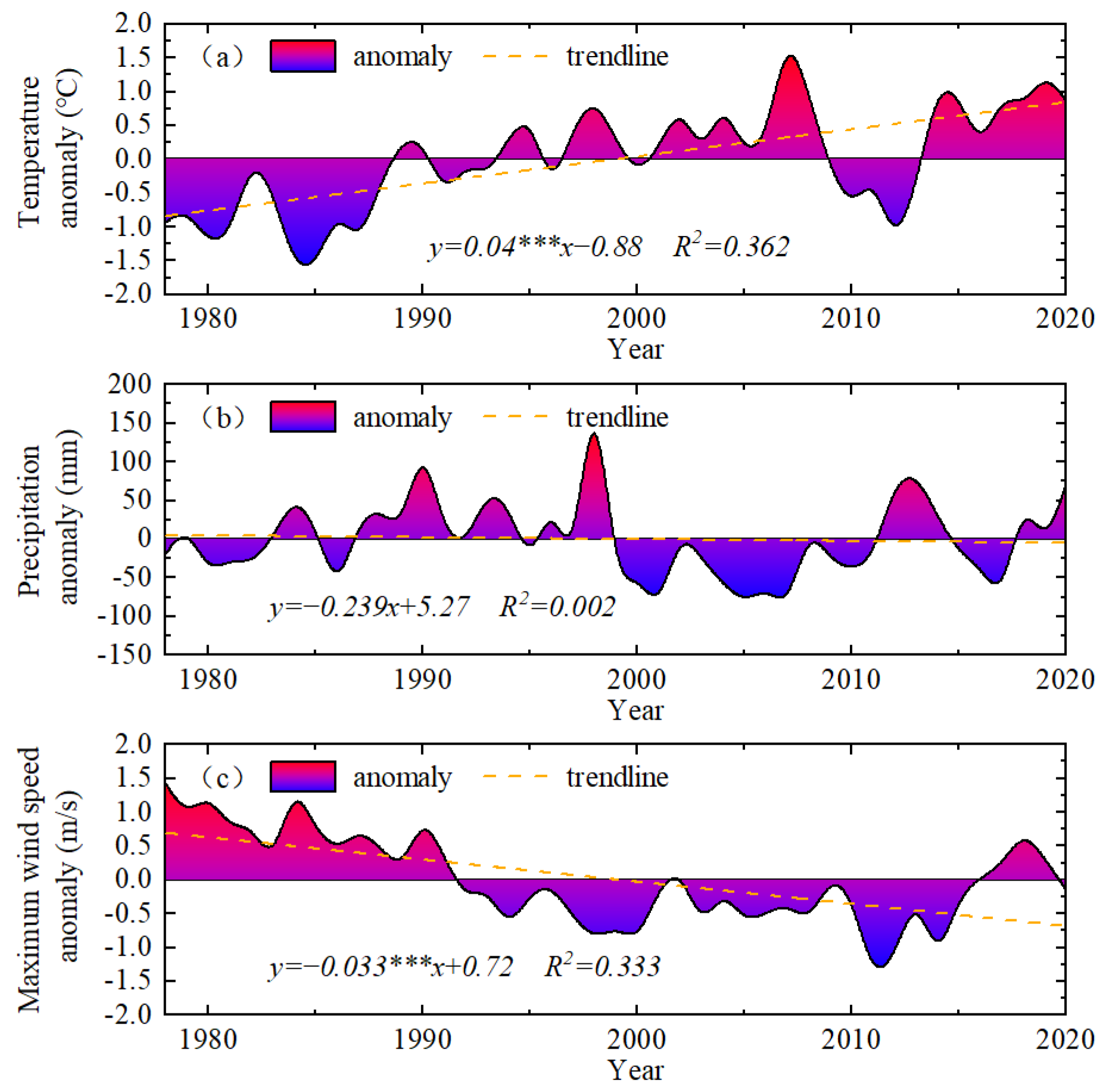
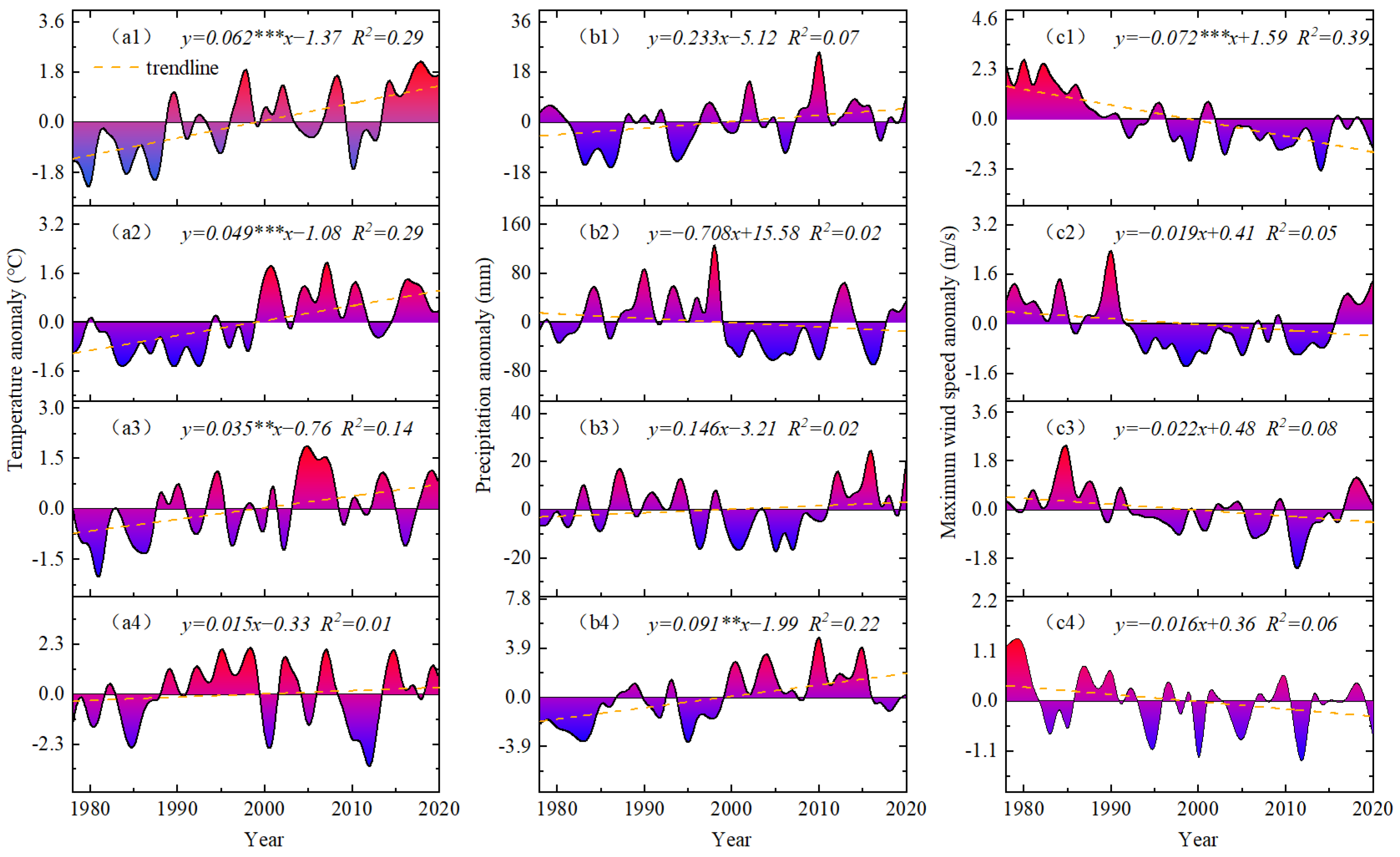
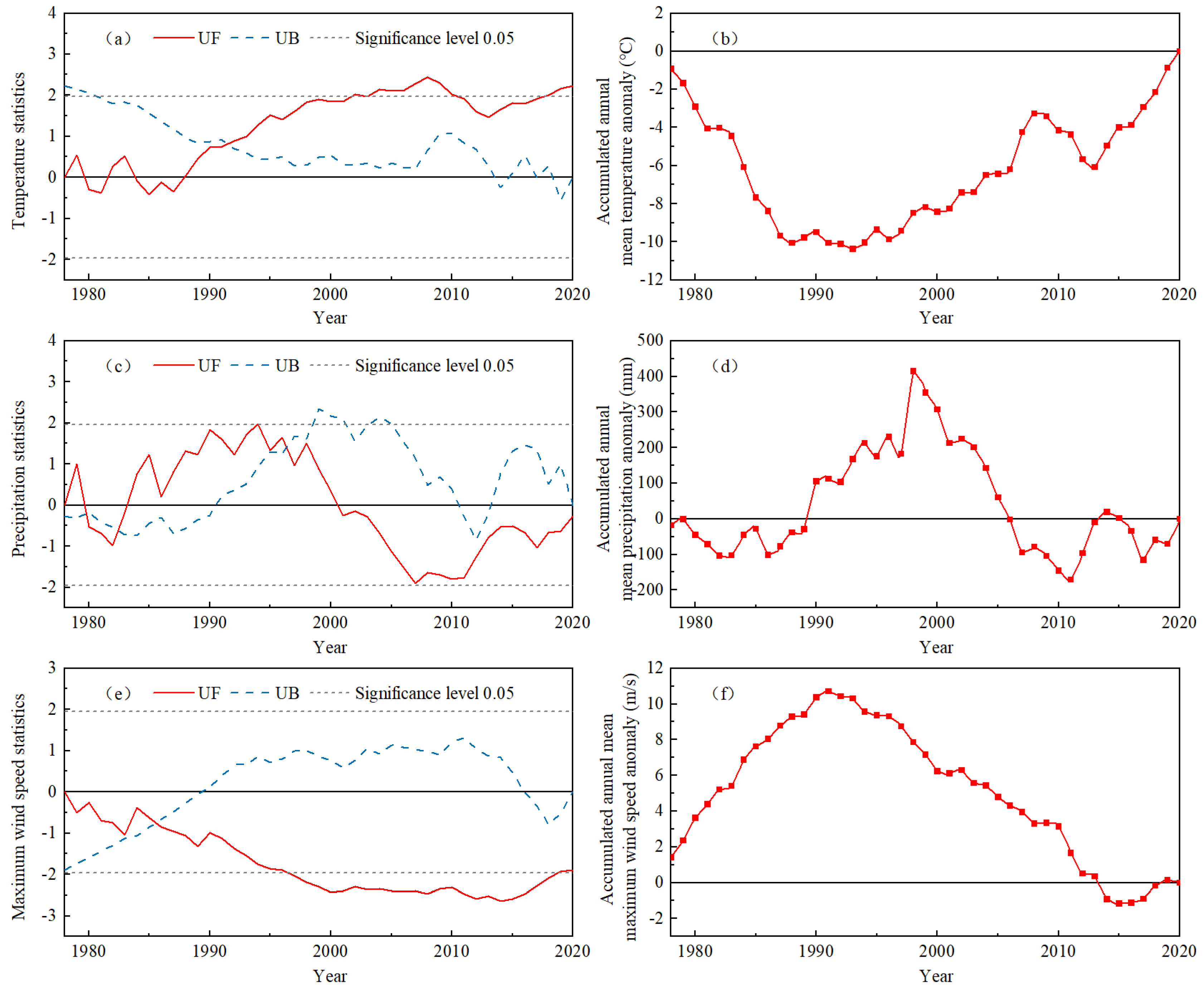
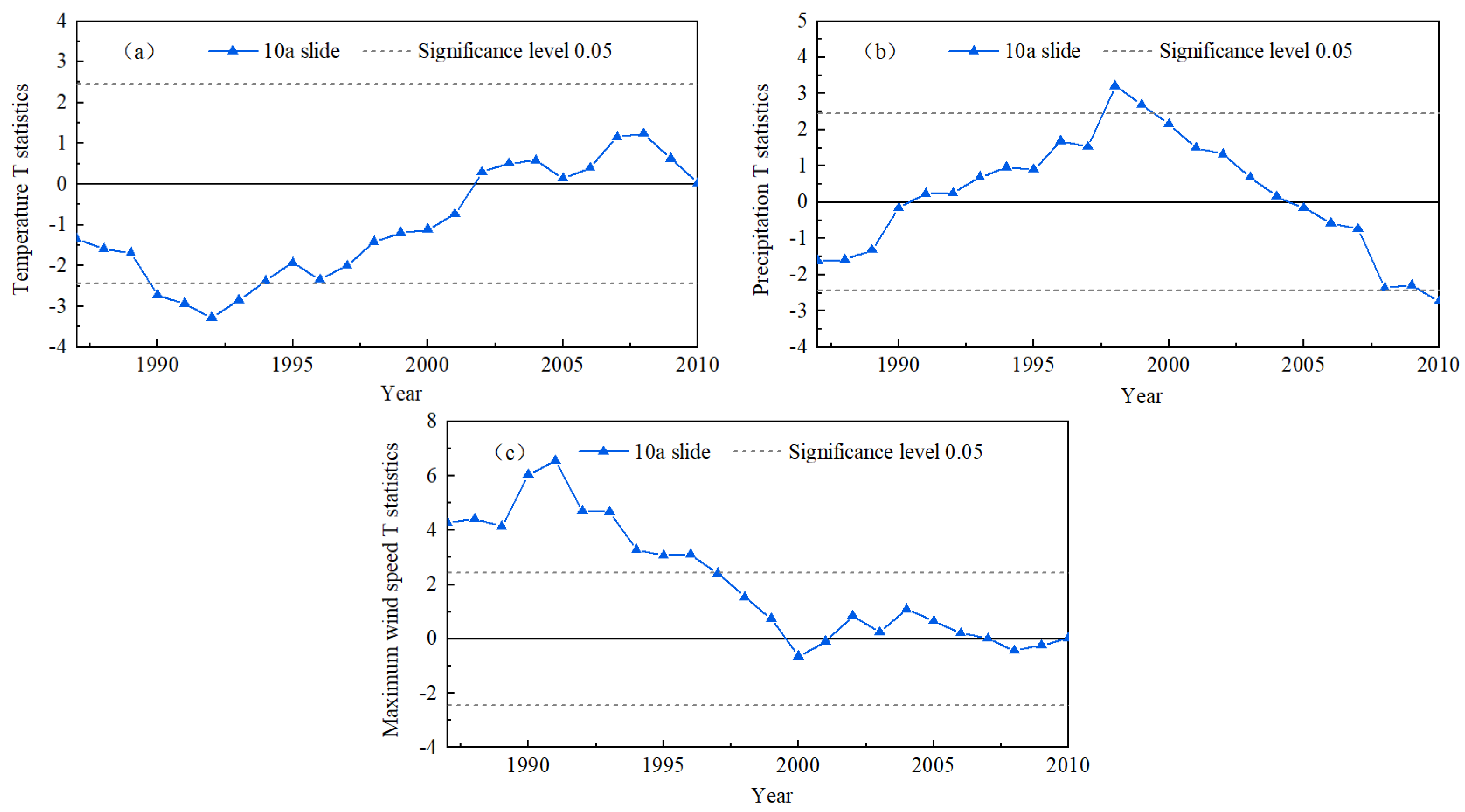
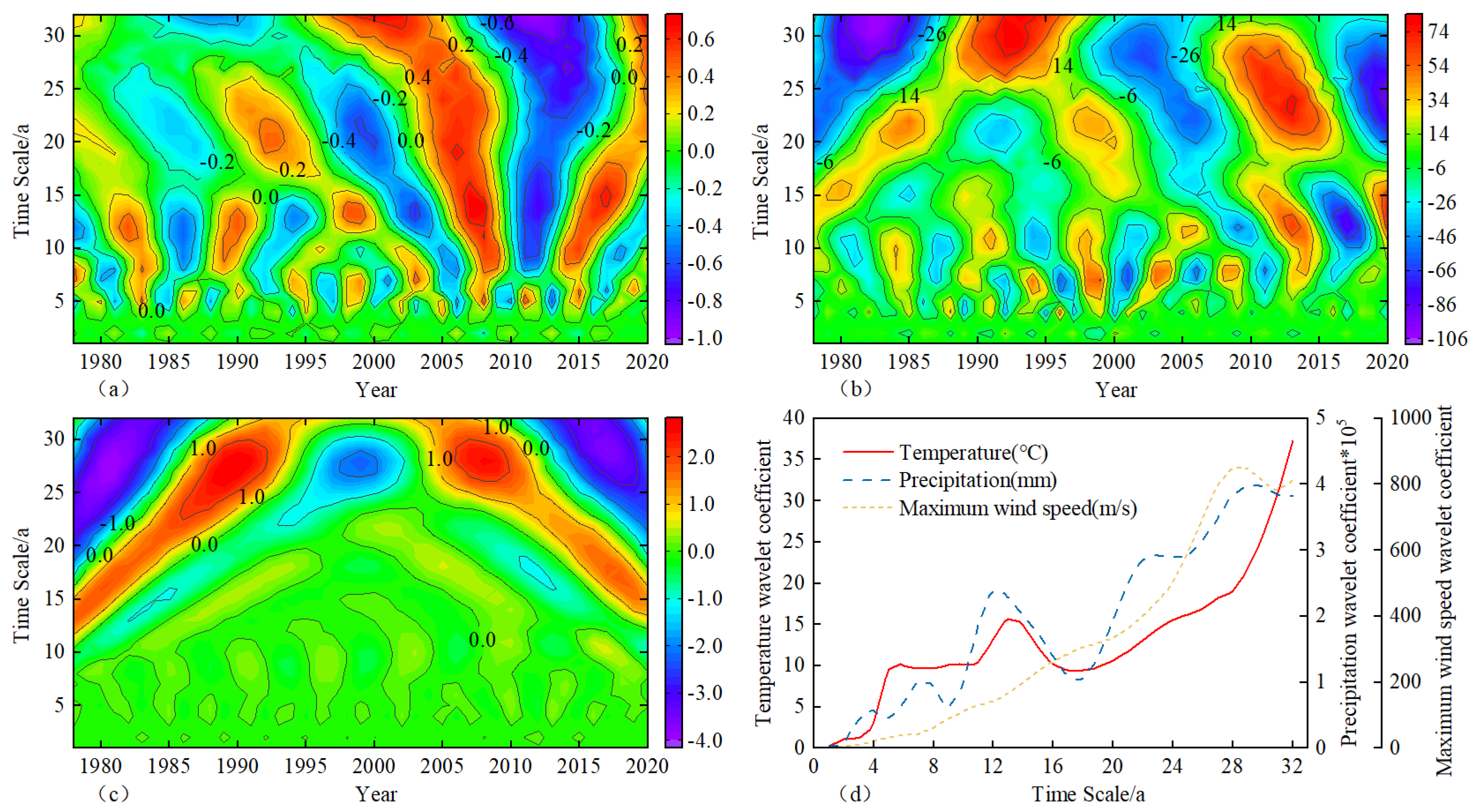

| Climate elements | Spring | Summer | Autumn | Winter | Interannual |
|---|---|---|---|---|---|
| temperature (°C/10a) | 0.62 *** | 0.49 *** | 0.35 ** | 0.15 | 0.4 *** |
| precipitation (mm/10a) | 2.33 | −7.08 | 1.46 | 0.91 ** | −2.39 |
| maximum wind speed (m/s/10a) | −0.72 *** | −0.19 | −0.22 | −0.16 | −0.33 *** |
| Climate Elements | Mann-Kendall Test | Cumulative Anomaly Test | Sliding t-Test | Mutation Year |
|---|---|---|---|---|
| temperature | 1991–1992 year | 1993 year | 1992 year | 1992 year |
| precipitation | 1980, 1983, 1997 year | 1998, 2011 year | 1998 year | 1998 year |
| Maximum wind speed | 1985–1986 year | 1991 year | 1991 year | 1991 year |
Publisher’s Note: MDPI stays neutral with regard to jurisdictional claims in published maps and institutional affiliations. |
© 2022 by the authors. Licensee MDPI, Basel, Switzerland. This article is an open access article distributed under the terms and conditions of the Creative Commons Attribution (CC BY) license (https://creativecommons.org/licenses/by/4.0/).
Share and Cite
He, B.; Tuya, W.; Qinchaoketu, S.; Nanzad, L.; Yong, M.; Kesi, T.; Sun, C. Climate Change Characteristics of Typical Grassland in the Mongolian Plateau from 1978 to 2020. Sustainability 2022, 14, 16529. https://doi.org/10.3390/su142416529
He B, Tuya W, Qinchaoketu S, Nanzad L, Yong M, Kesi T, Sun C. Climate Change Characteristics of Typical Grassland in the Mongolian Plateau from 1978 to 2020. Sustainability. 2022; 14(24):16529. https://doi.org/10.3390/su142416529
Chicago/Turabian StyleHe, Bu, Wulan Tuya, Si Qinchaoketu, Lkhagvadorj Nanzad, Mei Yong, Tang Kesi, and Changqing Sun. 2022. "Climate Change Characteristics of Typical Grassland in the Mongolian Plateau from 1978 to 2020" Sustainability 14, no. 24: 16529. https://doi.org/10.3390/su142416529
APA StyleHe, B., Tuya, W., Qinchaoketu, S., Nanzad, L., Yong, M., Kesi, T., & Sun, C. (2022). Climate Change Characteristics of Typical Grassland in the Mongolian Plateau from 1978 to 2020. Sustainability, 14(24), 16529. https://doi.org/10.3390/su142416529







